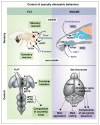Neural control of sexually dimorphic behaviors
- PMID: 23680385
- PMCID: PMC3820427
- DOI: 10.1016/j.conb.2013.04.005
Neural control of sexually dimorphic behaviors
Abstract
All sexually reproducing animals exhibit gender differences in behavior. Such sexual dimorphisms in behavior are most obvious in stereotyped displays that enhance reproductive success such as mating, aggression, and parental care. Sexually dimorphic behaviors are a consequence of a sexually differentiated nervous system, and recent studies in fruit flies and mice reveal novel insights into the neural mechanisms that control these behaviors. In the main, these include a diverse array of novel sex differences in the nervous system, surprisingly modular control of various stereotyped dimorphic behavioral routines, and unanticipated sensory and central modulation of mating. We start with a brief overview to provide the appropriate conceptual framework so that the advances made by the newer studies discussed subsequently can be fully appreciated. We restrict our review to reporting progress in understanding the basis of mating and aggression in fruit flies and mice.
Copyright © 2013 Elsevier Ltd. All rights reserved.
Figures


Similar articles
-
Molecular and neural control of sexually dimorphic social behaviors.Curr Opin Neurobiol. 2016 Jun;38:89-95. doi: 10.1016/j.conb.2016.04.015. Epub 2016 May 7. Curr Opin Neurobiol. 2016. PMID: 27162162 Free PMC article. Review.
-
Neurogenetics of courtship and mating in Drosophila.Adv Genet. 2008;62:67-184. doi: 10.1016/S0065-2660(08)00603-2. Adv Genet. 2008. PMID: 19010254 Review.
-
Neural control of sexually dimorphic social behaviors.Curr Opin Physiol. 2018 Dec;6:89-95. doi: 10.1016/j.cophys.2018.08.003. Epub 2018 Sep 3. Curr Opin Physiol. 2018. PMID: 31535059 Free PMC article.
-
Decoding sex differences: how GABA shapes Drosophila behavior.Curr Opin Insect Sci. 2025 Feb;67:101293. doi: 10.1016/j.cois.2024.101293. Epub 2024 Oct 28. Curr Opin Insect Sci. 2025. PMID: 39471909 Review.
-
A circuit logic for sexually shared and dimorphic aggressive behaviors in Drosophila.Cell. 2021 Jan 21;184(2):507-520.e16. doi: 10.1016/j.cell.2020.11.048. Epub 2020 Dec 30. Cell. 2021. PMID: 33382967 Free PMC article.
Cited by
-
The joy of sex pheromones.EMBO Rep. 2013 Oct;14(10):874-83. doi: 10.1038/embor.2013.140. Epub 2013 Sep 13. EMBO Rep. 2013. PMID: 24030282 Free PMC article. Review.
-
G-protein signaling is required for increasing germline stem cell division frequency in response to mating in Drosophila males.Sci Rep. 2020 Mar 3;10(1):3888. doi: 10.1038/s41598-020-60807-8. Sci Rep. 2020. PMID: 32127590 Free PMC article.
-
The role of fruitless in specifying courtship behaviors across divergent Drosophila species.Sci Adv. 2024 Mar 15;10(11):eadk1273. doi: 10.1126/sciadv.adk1273. Epub 2024 Mar 13. Sci Adv. 2024. PMID: 38478605 Free PMC article.
-
Sex differences in Drosophila behavior: Qualitative and Quantitative Dimorphism.Curr Opin Physiol. 2018 Dec;6:35-45. doi: 10.1016/j.cophys.2018.04.004. Epub 2018 Apr 17. Curr Opin Physiol. 2018. PMID: 30386833 Free PMC article.
-
Neurons Underlying Aggression-Like Actions That Are Shared by Both Males and Females in Drosophila.J Neurosci. 2024 Oct 30;44(44):e0142242024. doi: 10.1523/JNEUROSCI.0142-24.2024. J Neurosci. 2024. PMID: 39317475 Free PMC article.
References
-
- Touhara K, Vosshall LB. Sensing odorants and pheromones with chemosensory receptors. Annu Rev Physiol. 2009;71:307–332. - PubMed
-
- Dulac C, Torello AT. Molecular detection of pheromone signals in mammals: from genes to behaviour. Nat Rev Neurosci. 2003;4:551–562. - PubMed
-
- Li Q, Korzan WJ, Ferrero DM, Chang RB, Roy DS, Buchi M, Lemon JK, Kaur AW, Stowers L, Fendt M, et al. Synchronous evolution of an odor biosynthesis pathway and behavioral response. Curr Biol. 2012 http://dx.doi.org/10.1016/j.cub.2012.10.047. - DOI - PMC - PubMed
Publication types
MeSH terms
Grants and funding
LinkOut - more resources
Full Text Sources
Other Literature Sources
Molecular Biology Databases

